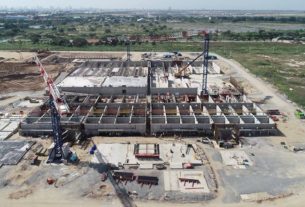Hitachi, a Japan-based multinational conglomerate, is relying on Thailand as its regional hub for the development of logistics and supply-chain networks for the Greater Mekong Subregion, said president and chief operating officer Toshiaki Higashihara.
Under the strategy, Hitachi will use its logistics operation in Thailand for cross-border transport of parts and components produced by the company and other Thai manufacturers to production facilities in Laos, Myanmar and Cambodia.
Hitachi will next year double its manufacturing capacity for elevators and escalators at its plant in Amata Nakorn Industrial Estate in Chon Buri province from currently 2,500 sets per annum to about 5,000 sets. However, the firm declined to disclose how much it would spend on this capacity expansion.
Higashihara said during the “Hitachi Innovation Forum” held in Singapore last week that Thailand offered huge business opportunities in power transmission and distribution (T&D) systems and railway systems.
Hitachi is currently using its core factory in Thailand to expand its elevator and escalator business to markets in India and the Middle East. It will also rely on Thailand as an important regional hub for developing logistics and supply chain networks in Indochina.
In collaboration with a local company, Hitachi has entered a contract with the Electricity Generating Authority of Thailand for supplying and constructing substations in Chaiyaphum. This includes an engineering, procurement and construction (EPC) contract, including 500-kilovolt gas-insulated switchgear (GIS). This time, Hitachi will supply the 500kV GIS and its associated work and the local company will supply a 230kV GIS as well as conduct civil engineering work, installation, and commissioning at the substations.
The contract was signed on November 4, and the work targeted for completion in 2016.
Higashihara said that based on the 2015 mid-term management plan, the Hitachi Group was accelerating the global roll-out of its “social innovation business”. Through this business, Hitachi aims to resolve social issues by combining its expertise in both social infrastructure and information technologies.
Driven by regional integration under the Asean Economic Community, which will be effective next year, the Asean market will probably expand.
“Everybody is keen on this Asean region as having huge market potential. For Hitachi, Asean is a very promising area to the company, considering the railway business. Our first step is to establish a global railway branch in Singapore to expand our railway-system business into this region. It is also required for the IT investment in this Asean region as well, ” Higashihara said.
“We decided to hold the Hitachi Innovation Forum in Singapore to demonstrate Hitachi’s further commitment to promoting growth in this region. Asean countries are already recognised as ideal bases for manufacturing, and now they also represent a huge market. As such, Asean has become an extremely important region for Hitachi as well,” he said.
Hitachi’s overall worldwide revenues were reported at 9.6 trillion yen (Bt2.6 trillion) in its 2013 fiscal year, and are expected to reach 10 trillion yen in fiscal 2015, with more than 350 billion yen in net income attributed to its shareholders.
According to Higashihara, Hitachi’s revenues for fiscal 2013 in Asia, including Asean countries, were about 989.9 billion yen, and the company was planning to increase this figure by about 30 per cent to 1.29 trillion yen in fiscal 2015. This figure excludes China, with revenues expected to surge from 1.07 trillion yen in fiscal 2013 to 1.22 trillion yen by fiscal 2015.
“Up to now, we have been rolling out a variety of businesses in this region, including infrastructure systems, high functional materials and components, construction machinery, automotive parts, and home appliances. In the future, we will expand our operations targeting two key business fields, which are the information and telecommunication systems business, with a focus on financial solutions, and the railway systems business,” Higashihara said.
He said that in the railway-system business, Hitachi had received an order from Singapore’s Sentosa Development Corporation for wireless signalling systems (communication based train control) for the Sentosa Express monorail. There is a particularly strong demand for CBTC in Asean countries, and the company is planning to establish a dedicated division for these systems at Hitachi Asia next April.
Higashihara said that in addition to Thailand, Hitachi had set its key strategies for particular countries in Asean.
Singapore, for instance, is the company’s hub and gateway for other Asean countries, thanks to its geographic superiority. Based in Singapore, Hitachi Asia is responsible for rolling out business in collaboration with the city-state’s Economic Development Board and other government agencies.
Hitachi Asia also serves as a base for the development of cutting-edge technologies and new business development in surrounding countries.
Indonesia, meanwhile, is the market with the most potential among Asean countries, and it is making investments in various types of infrastructure, including T&D, railways, and IT. Hitachi will provide GIS for Asean markets, and the company plans to be actively involved in subway and other mass-transit projects that are in the planning stage in Jakarta.
Malaysia is also expected to experience substantial growth in a number of markets, including oil and gas, IT, railways and finance. Hitachi is already actively involved in these markets. In addition, in 2012, the company acquired eBworx, a financial-solutions company, and also established an IT service company with Sunway Technology.
Vietnam is expected to invest in infrastructures such as T&D, railways, and urban planning and development systems. Last year, Hitachi received an order for Ho Chi Minh City Metro Line 1, and will expand its business targeting other train lines. The company’s goal is to secure new orders for other large-scale infrastructure projects financed by official development assistance.
The Philippines has the second-highest growth rate in Asia in terms of actual GDP, and the company is expanding business there in various fields, including social infrastructure, urban planning and development systems, and home appliances.
Source: http://www.nationmultimedia.com/business/Thailand-key-to-Hitachis-Asean-30248387.html
